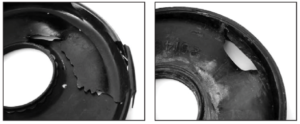
Models
All vehicles with gasoline fuel-injected engines and vacuum boosters.
Symptom
Booster failure due to ruptured diaphragm (hard pedal, no assist).
Cause
A rich-running engine due to improper fuel management causes excess gas or gasoline fumes to enter the booster, thus destroying the diaphragm.
Solution
Ensure proper operation of the fuel management system. Check for defective injectors, high fuel pressure, leaking fuel pressure regulator and proper ECM operation. Check the old booster for gasoline odor. If it smells like gas do not install the replacement unit until the problem is corrected (see photo).
NOTE: Another cause of diaphragm failure is master cylinder brake fluid entering the booster due to a faulty intermediate pushrod seal in the booster. If brake fluid is found between the master cylinder and the booster, the booster will have to be replaced.
Courtesy of CARDONE ProTech.











